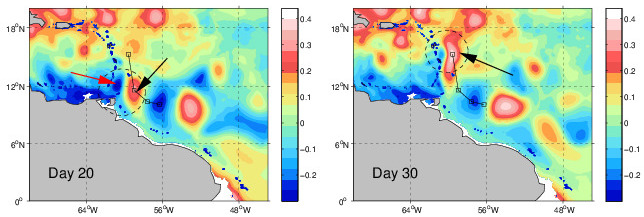Eddy-Corner interaction
 The dynamics of the North Brazil Current rings involve many complicated interactions (e.g.,shape of the topography, stratification, forcing). In order to clarify the vorticity dynamics in this region, we simplify the situation depicted in Fig. 1 as much as possible: we study the interaction of a barotropic (2d) vortex with a corner at a wall. The time integration of this model is shown in the movie (cf. below) where the topography is represented with the gray area. The initial condition is a Gaussian patch of negative vorticity placed next to the wall (Lamb-Oseen vortex).
The dynamics of the North Brazil Current rings involve many complicated interactions (e.g.,shape of the topography, stratification, forcing). In order to clarify the vorticity dynamics in this region, we simplify the situation depicted in Fig. 1 as much as possible: we study the interaction of a barotropic (2d) vortex with a corner at a wall. The time integration of this model is shown in the movie (cf. below) where the topography is represented with the gray area. The initial condition is a Gaussian patch of negative vorticity placed next to the wall (Lamb-Oseen vortex).
In the relative frame of reference centered on the vortex, the flow field of this vortex in the absence of the wall is given by the azimuthal profile
$$ v_\theta(r) = \frac{\Gamma}{2\pi r} \left(1-\exp\left(-\frac{r^2}{2r_0^2}\right)\right)\, , $$
with $r_0$ the pseudo radius of the vortex, and $\Gamma$ the strength the vortex. The vorticity pattern corresponding to this velocity field is a Gaussian bump
$$ \omega(r) = \frac{\Gamma}{2\pi r_0^2} \exp\left(-\frac{r^2}{2r_0^2}\right)\, .$$
We use the MITgcm to model the evolution of the vortex forward in time. The size of the domain is 500km$\times$500km with a grid resolution of 1250m. We use a harmonic viscosity coefficient of $\nu = 20$m$^2$s$^{-1}$ with free-slip boundary conditions, and a time step of $\Delta t=200$s. The vortex corresponds to an anticyclone ($\Gamma = -5\times 10^{4}$m$^2$s$^{-1}$) of initial pseudo-radius $r_0 = 20$km. The initial vortex is placed next to the wall, which imposes a no-normal flow boundary condition. The effect of this boundary condition is to deform the anticyclone such that the latter will propagate northward along the wall via the image effect. At day 10, the vortex reaches the corner and we observe the creation of positive vorticity at the tip of the corner which takes the form of a thin vortex filament that rolls up onto itself (day 20). Viscosity eventually smooths the filament into a uniform vortex patch with positive vorticity. This newly created patch forms a dipole with its anticyclonic partner and the dipole moves according to its own dynamics. In fact, such dipoles are known to be extremely robust, self-propagating structures. A vorticity filament remains attached to the corner as a remnant of the previous interaction.
The configuration files for this experiment may be found on github. Don't hesitate to ask if you have any issue with this configuration.
output.webm